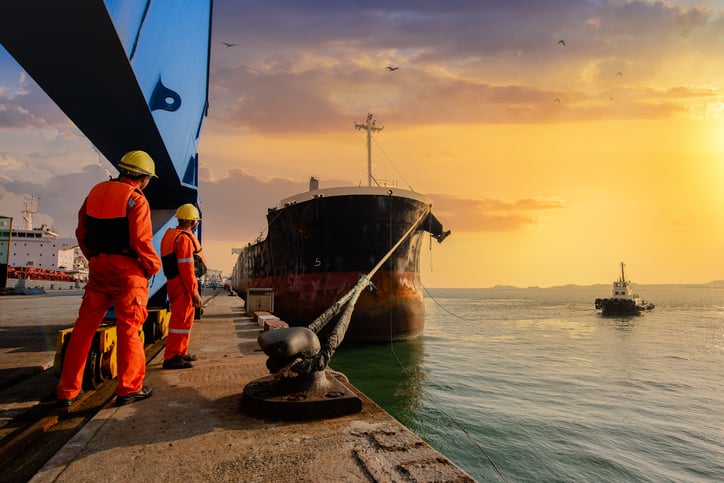Dockworking has long had one of the highest rates of lost workdays of any industry. Over the past 30 years, those who load and unload cargo have been seriously injured nearly three times as often as other workers. It's a challenge that calls for strong safety cultures, and QSL—a global leader in marine cargo handling—has risen to it.
Named one of Canada's most admired corporate cultures, QSL has spent more than a century refining its safety standards. And their Chicago facility is even a two-time winner of The American Equity Underwriters, Inc.'s (AEU) Safety Award Program, thanks largely to the efforts of people like Rudy Becerra.
As the Safety and Compliance Manager for QSL America, Becerra has spent more than 14 years making his industry safer. And in a recent interview with AEU LEAD, he shared some remarkable insights on how to create a positive safety culture in the workplace.
What is safety culture?
Dockworkers (also called stevedores or longshoremen) have a unique and centuries-long culture. It's tough work that, in the words of the National American History Museum, demands "ingenuity, experience, brawn, and teamwork."
Over the past hundred years, new technologies—from shipping containers to hard hats—have helped improve safety in this high-hazard industry. The trick, says Becerra, is getting people on board. "We have every tool available to be safer than we've ever been. But there's been a culture differential."
For Becerra, building that culture is a way of life—and it's a make-or-break responsibility for any business. "Years ago, I asked a senior manager 'What is safety culture?' I'll never forget his response: He said it's 'the collective summary of all decisions, actions, and consequences in the history of a company.'"
Safety culture is culture. It's more than knowing the rules: It's about collaboration, trust, and support. "At the end of the day, safety really boils down to the human factor. Safety culture creates a safe and judgment-free environment, where you know what you need to do and how to do it properly—with procedures and a safety-minded perspective."
Who's responsible for safety—and making changes 'stick'?
Studies have found that organizations with a positive safety culture tend to have fewer injuries and a reduced tolerance for unnecessary risk. But not everybody plays the same part in making that culture a reality. Executives, managers, and front-line workers each make unique contributions to the fight against on-the-job illness and injury.
For Becerra, building a safety culture in the workplace requires good leadership and a healthy helping of top-down support. Commitment from senior leadership is, in his words, "where your backbone starts"—but it's up to managers to realize that vision. "Middle management has the most important part of safety culture. They're the ones that our employees look to be led by."
Good leadership—built on influence and respect, not just authority—connects executive decisions with employee buy-in. And when it comes to helping rank-and-file workers internalize new safety standards, Becerra has a recommendation: Make them part of the process. "As a safety manager, I can put any kind of standard operating procedure together. But if they're not involved, they're going to turn around and say, 'Well, what does he know?'"
Becerra's team works constantly to eliminate risks by fine-tuning their standard operating procedures (SOPs). But when it comes to building a positive safety culture—one where workers see the wisdom of the rules—collaboration is key. "They understand what the dangers are," says Becerra. "They're the ones, bottom line, doing the job. They're the ones that see the safety part of the job, whether it be unloading or loading a vessel, a barge, or a rail car."
"So we ask them 'What should we do here? Here's our SOP.'"
How do you take safety culture to the next level?
Top-down approaches may work in day-to-day operations, but when it comes to long-term change, buy-in—making followers want to follow—is a must. Communication, conflict resolution, and participative leadership can make the difference between being seen as an authority figure or a role model. And building rapport is vital, adds Becerra. " Workers want to be part of something. By involving them and listening to their ideas, you’ll get their buy-in and support – a very important part of creating a strong safety culture."
It's crucial to show workers that safety matters—that they'll always leave work better off. But it takes a commitment to safety culture and, ultimately, genuine compassion. "A huge part of safety culture," Becerra adds, "is making sure that your middle managers do care about each employee. It shows not only that your manager cares about you, but the company cares about you."
And companies can also demonstrate that commitment through education. Coaching in leadership techniques (particularly people skills) can help supervisors form bonds with employees that drive results. So can training programs like AEU LOOK, which offers maritime workers life-saving situational awareness tips—and remains a tool used by Becerra's team to this day.
Safety culture and business success go hand-in-hand. And in the end, says Becerra, those efforts pay off. "Without safety, you're not going to have employees. And without operations, you're not going to have the business, right? So we continue to look for ways to improve our middle management, and our employees, to get to the next level."
This article was originally published in the AEU LEAD blog on December 6, 2021.
AEU LEAD arms executives and supervisors with the tools they need to build positive safety cultures and better businesses. For more on what AEU LEAD has to offer, please explore their services or contact a member of the team.


